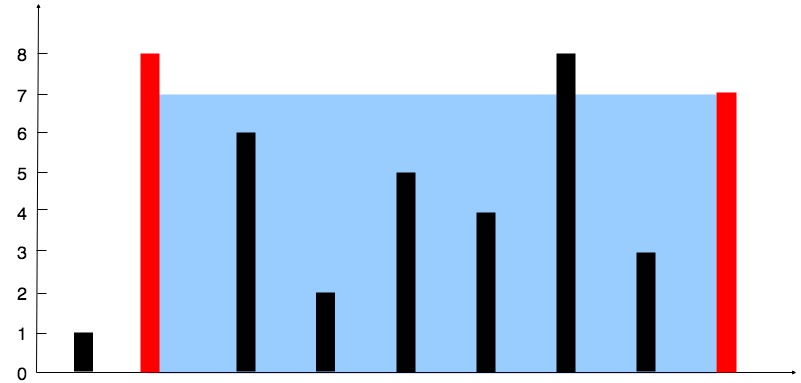LeetCode Hot 100 (2) 双指针
# 283.移动零 (opens new window)
题目:
给定一个数组 nums,编写一个函数将所有 0 移动到数组的末尾,同时保持非零元素的相对顺序。
请注意 ,必须在不复制数组的情况下原地对数组进行操作。
示例 1:
输入: nums = [0,1,0,3,12]
输出: [1,3,12,0,0]
2
示例 2:
输入: nums = [0]
输出: [0]
2
提示:
- 1 <= nums.length <= 10^4
- -2^31 <= nums[i] <= 2^31 - 1
进阶:你能尽量减少完成的操作次数吗?
思路:
用快慢指针,快指针遍历每个数,慢指针对应的位置存非零的数,之后补0
代码:
C++代码
class Solution {
public:
void moveZeroes(vector<int>& nums) {
int slowIndex = 0;
for(int fastIndex=0;fastIndex<nums.size();fastIndex++) {
if(nums[fastIndex]!=0) nums[slowIndex++] = nums[fastIndex];
}
for(int i=slowIndex;i<nums.size();i++) nums[i] = 0;
}
};
2
3
4
5
6
7
8
9
10
Go代码
func moveZeroes(nums []int) {
slowIndex := 0
for fastIndex:=0;fastIndex<len(nums);fastIndex++ {
if nums[fastIndex]!=0 {
nums[slowIndex] = nums[fastIndex]
slowIndex++
}
}
for i:=slowIndex;i<len(nums);i++ {
nums[i] = 0
}
}
2
3
4
5
6
7
8
9
10
11
12
# 11.盛最多水的容器 (opens new window)
题目:
给定一个长度为 n 的整数数组 height 。有 n 条垂线,第 i 条线的两个端点是 (i, 0) 和 (i, height[i]) 。
找出其中的两条线,使得它们与 x 轴共同构成的容器可以容纳最多的水。
返回容器可以储存的最大水量。
说明:你不能倾斜容器。
示例 1:

输入:[1,8,6,2,5,4,8,3,7]
输出:49
解释:图中垂直线代表输入数组 [1,8,6,2,5,4,8,3,7]。在此情况下,容器能够容纳水(表示为蓝色部分)的最大值为 49。
2
3
示例 2:
输入:height = [1,1]
输出:1
2
提示:
- n == height.length
- 2 <= n <= 10^5
- 0 <= height[i] <= 10^4
思路:
左右两侧定义指针,用贪心的方式,每次移动高度相对较小的那一侧
代码:
C++代码
class Solution {
public:
int maxArea(vector<int>& height) {
int res = 0;
int i = 0, j = height.size()-1;
while(i<j) {
int temp = min(height[i], height[j])*(j-i);
res = max(res, temp);
if(height[i]<height[j]) i++;
else j--;
}
return res;
}
};
2
3
4
5
6
7
8
9
10
11
12
13
14
Go代码
func maxArea(height []int) int {
res := 0
i, j := 0, len(height)-1
for i<j {
temp := min(height[i],height[j])*(j-i)
res = max(res, temp)
if height[i] < height[j] {
i++
} else {
j--
}
}
return res
}
2
3
4
5
6
7
8
9
10
11
12
13
14
# 15.三数之和 (opens new window)
题目:
给你一个整数数组 nums ,判断是否存在三元组 [nums[i], nums[j], nums[k]] 满足 i != j、i != k 且 j != k ,同时还满足 nums[i] + nums[j] + nums[k] == 0 。请
你返回所有和为 0 且不重复的三元组。
注意:答案中不可以包含重复的三元组。
示例 1:
输入:nums = [-1,0,1,2,-1,-4]
输出:[[-1,-1,2],[-1,0,1]]
解释:
nums[0] + nums[1] + nums[2] = (-1) + 0 + 1 = 0 。
nums[1] + nums[2] + nums[4] = 0 + 1 + (-1) = 0 。
nums[0] + nums[3] + nums[4] = (-1) + 2 + (-1) = 0 。
不同的三元组是 [-1,0,1] 和 [-1,-1,2] 。
注意,输出的顺序和三元组的顺序并不重要。
2
3
4
5
6
7
8
示例 2:
输入:nums = [0,1,1]
输出:[]
解释:唯一可能的三元组和不为 0 。
2
3
示例 3:
输入:nums = [0,0,0]
输出:[[0,0,0]]
解释:唯一可能的三元组和为 0 。
2
3
提示:
- 3 <= nums.length <= 3000
- -10^5 <= nums[i] <= 10^5
思路:
先排序,然后针对每个数对其右侧的数找两数之和符合要求的数,找两数之和符合要求的数可以定义左右指针进行遍历,要注意针对可能重复的情况进行处理,这样的话时间复杂度就是O(n^2)。
代码:
C++代码
class Solution {
public:
vector<vector<int>> threeSum(vector<int>& nums) {
sort(nums.begin(),nums.end());
vector<vector<int>> res;
for(int i=0;i<nums.size();i++) {
if(i>0&&nums[i]==nums[i-1]) continue;
int j = i+1, k = nums.size()-1;
while(j<k) {
if(nums[i]+nums[j]+nums[k]>0) k--;
else if(nums[i]+nums[j]+nums[k]<0) j++;
else {
res.push_back({nums[i],nums[j],nums[k]});
while(j<k&&nums[j]==nums[j+1]) j++;
while(j<k&&nums[k]==nums[k-1]) k--;
j++;
k--;
}
}
}
return res;
}
};
2
3
4
5
6
7
8
9
10
11
12
13
14
15
16
17
18
19
20
21
22
23
Go代码
func threeSum(nums []int) [][]int {
res := make([][]int,0)
slices.Sort(nums)
for i:=0;i<len(nums);i++ {
if i>0&&nums[i]==nums[i-1] {
continue
}
j, k := i+1, len(nums)-1
for j<k {
if nums[i]+nums[j]+nums[k]>0 {
k--
} else if nums[i]+nums[j]+nums[k]<0 {
j++
} else {
res = append(res,[]int{nums[i],nums[j],nums[k]})
for j<k&&(nums[j]==nums[j+1]) {
j++
}
for j<k&&(nums[k]==nums[k-1]) {
k--
}
j++
k--
}
}
}
return res
}
2
3
4
5
6
7
8
9
10
11
12
13
14
15
16
17
18
19
20
21
22
23
24
25
26
27
28
# 42.接雨水 (opens new window)
题目:
给定 n 个非负整数表示每个宽度为 1 的柱子的高度图,计算按此排列的柱子,下雨之后能接多少雨水。
示例 1:
输入:height = [0,1,0,2,1,0,1,3,2,1,2,1]
输出:6
解释:上面是由数组 [0,1,0,2,1,0,1,3,2,1,2,1] 表示的高度图,在这种情况下,可以接 6 个单位的雨水(蓝色部分表示雨水)。
2
3
示例 2:
输入:height = [4,2,0,3,2,5]
输出:9
2
提示:
- n == height.length
- 1 <= n <= 2 * 10^4
- 0 <= height[i] <= 10^5
思路:
定义两个单调栈分别用来获取每个位置左右两侧最大的高度,然后遍历一遍数组,根据左右两侧最大高度的最小值即可得到这个位置存水量,相加每个位置存水量即可得到答案。
代码:
C++代码
class Solution {
public:
int trap(vector<int>& height) {
int n = height.size();
vector<int> left_max(n);
//构建一个单调递减的单调栈,用数组模拟单调栈,找每个元素左边最大的元素的位置
vector<int> stk1(n);
int st = -1;
for(int i=0;i<n;i++) {
if(st==-1) {
left_max[i]=-1;
stk1[++st] = i;
continue;
}
while(st>=0&&height[i]>=height[stk1[st]]) st--;
if(st==-1) {
left_max[i]=-1;
} else {
left_max[i] = stk1[0];
}
stk1[++st] = i;
}
vector<int> right_max(n);
//构建一个单调递减的单调栈,用数组模拟单调栈,找每个元素右边最大的元素的位置
vector<int> stk2(n);
st = -1;
for(int i=n-1;i>=0;i--) {
if(st==-1) {
right_max[i]=-1;
stk2[++st] = i;
continue;
}
while(st>=0&&height[i]>=height[stk2[st]]) st--;
if(st==-1) {
right_max[i]=-1;
} else {
right_max[i] = stk2[0];
}
stk2[++st] = i;
}
int res = 0;
for(int i=0;i<n;i++) {
if(left_max[i]==-1||right_max[i]==-1) continue;
else {
int temp = min(height[left_max[i]],height[right_max[i]]);
res += temp - height[i];
}
}
return res;
}
};
2
3
4
5
6
7
8
9
10
11
12
13
14
15
16
17
18
19
20
21
22
23
24
25
26
27
28
29
30
31
32
33
34
35
36
37
38
39
40
41
42
43
44
45
46
47
48
49
50
51
52
Go代码
func trap(height []int) int {
n := len(height)
left_max := make([]int, n)
stk1 := make([]int,n)
st := -1
for i:=0;i<n;i++ {
if st==-1 {
left_max[i] = -1
st++
stk1[st] = i
continue
}
for st>=0&&height[stk1[st]]<=height[i] {
st--
}
if st==-1 {
left_max[i] = -1
} else {
left_max[i] = stk1[0]
}
st++
stk1[st] = i
}
right_max := make([]int, n)
stk2 := make([]int,n)
st = -1
for i:=n-1;i>=0;i-- {
if st==-1 {
right_max[i] = -1
st++
stk2[st] = i
continue
}
for st>=0&&height[stk2[st]]<=height[i] {
st--
}
if st==-1 {
right_max[i] = -1
} else {
right_max[i] = stk2[0]
}
st++
stk2[st] = i
}
res := 0
for i:=0;i<n;i++ {
if left_max[i]==-1||right_max[i]==-1 {
continue
}
temp := min(height[left_max[i]],height[right_max[i]])
res += temp-height[i]
}
return res
}
2
3
4
5
6
7
8
9
10
11
12
13
14
15
16
17
18
19
20
21
22
23
24
25
26
27
28
29
30
31
32
33
34
35
36
37
38
39
40
41
42
43
44
45
46
47
48
49
50
51
52
53
54
55
56
